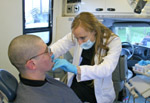|
By Cindy
Abole
Public Relations
Studying the
use of smokeless tobacco among
men, ages 18 to 24, and evaluating
their risk for oral cancer at The
Citadel were the goals of
third-year dental students Laura
Tulga and Jennie Odom. What's
especially interesting is that
these students were comparing
research used today from a study
conducted a decade ago by fellow
students. They were under the
guidance of J. Mark Barry, DDS,
associate dean for clinical
affairs in the College of Dental
Medicine.
 Third-year dental
student Laura Tulga inspects for
lesions in the mouth of Citadel
cadet Henry Mills. Third-year dental
student Laura Tulga inspects for
lesions in the mouth of Citadel
cadet Henry Mills.
In December,
the pair initiated some on-site
screenings of smokeless tobacco
use among volunteer participants
at The Citadel's campus. Using the
Dream Center's mobile dental
clinic van (the vehicle previously
belonged to the college),
participants completed a brief
survey and oral examination
conducted by a member of the study
team.
"This project allows us to study
and assess the alarmingly high use
of smokeless tobacco among Citadel
cadets," said Barry.
Cadets who
presented with precancerous
lesions were advised to refrain or
reduce their use of smokeless
tobacco products for a six-week
period. In January, those
individuals were invited to return
to the van to be evaluated for any
visual changes in their cheeks,
gums or mouth. The team compared
results from both screenings and
with national averages.
"Our goal was
to determine if Citadel cadets
were still experiencing a higher
rate of precancerous lesions than
smokeless tobacco users in the
general population as they were in
2001," according to Odom.
Results showed
that Citadel cadets screened for
smokeless tobacco keratosis
decreased in the 10 years since
the 2001 study from 72.3 percent
to 56 percent. This study resulted
in a lower incidence of finding
precancerous grade lesions in the
mouth compared to the 40 to 60
percent national average reported
in 2001.
The study
caught the attention of cadet
Henry Mills who was among a
several dozen Citadel students who
use smokeless tobacco and
consented to participate. As
smoking is banned within the Corps
of Cadets, Mills and other
students choose to use smokeless
tobacco to relax and destress. The
cadet from Myrtle Beach said he
had been dipping for the past five
years and admitted that he had
considered quitting as part of his
New Year's resolution.
Tulga asked participants to
complete a consent and
questionnaire that asked
participants if they were smokers
or users of smokeless tobacco, how
often they had used these products
and if they attempted to quit.
During the noninvasive oral exams,
she conducted a visual and finger
check of participants' mouths
looking for suspicious lesions.
Tulga and Odom
were looking for some wavy lines
and suspicious wrinkles in the
cadet-participant's gum line.
Research shows that early
detection and treatment of a
precancerous lesion significantly
decreases the likelihood that the
lesion will develop into cancer.
If something
looked suspicious, both Tulga and
Odom presented the patient with
some American Cancer Society
smokeless tobacco literature and
other support materials. For
participants identified with
precancerous lesions, they were
referred to their dentist for
treatment.
The study
revealed a lower incidence of
precancerous lesions than the
national average but a higher
occurrence of multiple lesions for
those who were affected. Results
revealed almost no change in the
severity of smokeless tobacco
keratosis among Citadel cadets in
the last decade.
On Feb. 26, the
pair joined other dental students
who presented their oral health
research in the junior category of
table clinics of the College of
Dental Medicine's Scholar's Day
activities.
|



 Third-year dental
student Laura Tulga inspects for
lesions in the mouth of Citadel
cadet Henry Mills.
Third-year dental
student Laura Tulga inspects for
lesions in the mouth of Citadel
cadet Henry Mills.